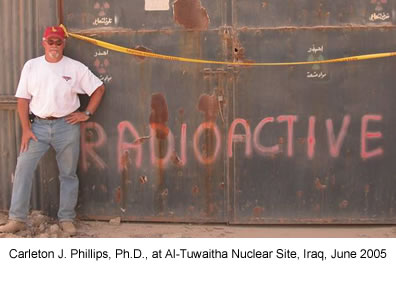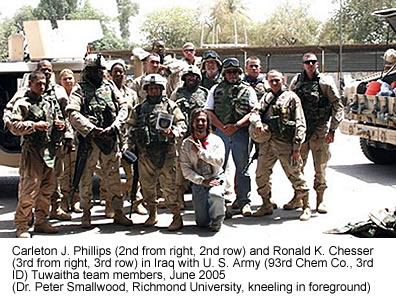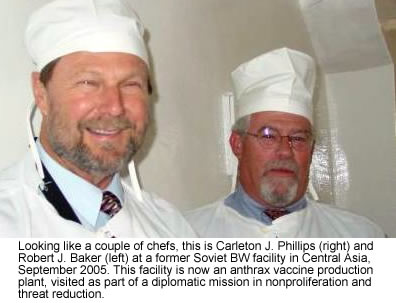Carleton J. Phillips
- Ph.D., Systematics and Ecology, The University of Kansas (1969)
- M.A., Zoology, The University of Kansas (1967)
- B.S., Zoology, Michigan State University (1964)

Research Interests
United States National Security Policy and Threat Reduction
As a scholar, my research and field work addresses national security issues and policy involving proliferation threat reduction, use of disease surveillance as a means of preparedness, and redirection of WMD personnel in the former Soviet Union and Iraq. I served as a William C. Foster Fellow in the Office of Proliferation Threat Reduction, United States Department of State (2003-2004), Special Advisor on Nonproliferation to the Coalition Provisional Authority (CPA), Office of National Security Affairs, Baghdad, Iraq (2003-2004), State Department Consultant on Iraq (2004-2005), and Senior Science Advisor on Iraq and Central Asia (former Soviet republics) to the United States Civilian Research & Development Foundation (2006- ). While serving as a Foster Fellow I was instrumental in developing the State Department Iraq WMD Personnel Redirection Program (Iraq Interim Center for Science & Industry-IICSI) and in Iraq took part in implementing the program, developing the Iraq Radioactive Source Regulatory Authority (IRSRA), and briefing CPA and Iraq Interim Government National Security and Nonproliferation Committees.
Research Interests in Mammalian Biology
As a scientist I am interested in the evolutionary biology, biodiversity, and biogeography of mammals. My approach has included the use of molecular genetics, comparative cell ultrastructure, histology, and histochemistry, to address questions about adaptation, cellular-level evolution, and organ systems. Mammalian salivary glands serve as a model system for my work, which includes discovery of new cell types, organelles, and new data on viral replication.
Honors
Texas Tech University Faculty Distinguished Leadership Award; C. Hart Merriam Research Award, American Society of Mammalogists; William C. Foster Fellowship in Nonproliferation and Proliferation Threat Reduction, United States Department of State; Tribute of Appreciation (Iraq service), Secretary of State, U. S. Department of State; Recognitions from the Coalition Provisional Authority (CPA, L. Paul Bremer) and Department of Defense for Iraq service; United States National Academy of Science-USSR Academy of Sciences exchange scientist; invited speaker at numerous international meetings: Japan; Jordan; Argentina; Finland; Spain; India; former Soviet Union, Austria (UN-IAEA); Hofstra University Faculty Distinguished Service Award.
Recent Invited Presentations
- Hofstra University, Hempstead, NY, “Nonproliferation, bioweapons, and the WMD Redirection Program in Iraq” and “Life Beyond the Textbook: WMD Personnel Redirection, Politics, and Iraq.”
- United States National Academies of Science, Washington, DC, invited lecture, July, “The Al-Tuwaitha Project, WMD Personnel Redirection, and Reconstruction of Science in Iraq.”
- International Conference on Al-Tuwaitha, Amman, Jordan, “The International Tuwaitha Project: A Step in the Reconstruction of Science and Technology in Iraq.” (Plenary session speech).
- International Conference on Al-Tuwaitha, Amman, Jordan, “The Al-Tuwaitha Project: An International Team Approach to Radioactive and other Contamination of Public Health Significance in Iraq.”
- International Nonproliferation Roundtable, Bishkek, Kyrgyzstan (as Head of Department of State delegation), “Strategic Plan for Disease Surveillance Projects in Kyrgyzstan.”
- International Conference on Environmental Contamination in Iraq, Amman, Jordan, “Historical Overview of SSWAT-1: Nonproliferation, Intellectual Capital, and the Reconstruction of Science and Technology in Iraq.”
- International Conference on Environmental Contamination in Iraq, Amman, Jordan, “The Al-Tuwaitha Project: An International Approach To Characterization of Environmental Contamination of Public Health Significance in Iraq.”
- UN-IAEA conference on decommissioning and decontamination of former nuclear sites in Iraq (member of United States Delegation to IAEA in Vienna), “The United States Iraq WMD Personnel Redirection Program and the Reconstruction of Science and Technology in Iraq.
Carleton J. Phillips, invited presentations, July 2006
- United States Department of State, Interagency Roundtable on Animal Disease and Public Health, “Zoonoses, Disease Surveillance, and Biosecurity.”
- International Conference on Infectious Disease, Zoonoses, and Disease Surveillance in Iraq, held in Amman, Jordan, “Evolution of Global Bio Threat Reduction: Biosecurity Engagement Program.” (presented on behalf of the U. S. Department of State)
- International Conference on Infectious Disease, Zoonoses, and Disease Surveillance in Iraq, held in Amman, Jordan, “Emergent, Zoonotic Diseases and the Challenge of Global Disease Surveillance.”
- International Strategic Planning Workshop, National Disease Surveillance, Ysyk-Köl, Kyrgyzstan, “Strategic Thinking about Disease Surveillance.” (Member of U. S. Department of State Delegation)
Field Research/Project Experience
- Al-Tuwaitha Nuclear Facility, Iraq
- Kyrgyzstan
- Kazakhstan
- Pakistan
- India
- Thailand
- New Guinea
- Ukraine
- Finland
- Kenya
- Ecuador
- Suriname
- French Guinea
- Argentina
- Central America and Mexico
- Cuba
- Greater and Lesser Antilles and Trinidad
Recent Book
Going Afield Lifetime Experiences in Exploration, Science, and the Biology of Mammals, C. J. Phillips and C. Jones (coeditors and authors), Museum of Texas Tech University, 2005, 289 pages.



Selected Publications
- 2006. Interlobular Excretory Ducts of Mammalian Salivary Glands: Structural and Histochemical Review. The Anatomical Record Part A: Discoveries in Molecular, Cellular, and Evolutionary Biology, 288A:498-526. By Bernard Tandler, Carlin A. Pinkstaff, and Carleton J. Phillips.
- 2005. Ken Ward in the Jungle: Making Scientific Sense of Field Work. Pp. 85-128, by C. J. Phillips in Going Afield. Lifetime Experiences in Exploration, Science, and the Biology of Mammals. TexasTech University, by C. J. Phillips and C. Jones (eds.), 289 pp.
- 2005. Going Afield: The Making of North American Mammalogists and their Science, Pp. 1-32, by C. J. Phillips, C. Jones, and R. H. Baker in Going Afield. Lifetime Experiences in Exploration, Science, and the Biology of Mammals. TexasTech University, by C. J. Phillips and C. Jones (eds.), 289 pp.
- 2004. Capturing Saddam. Virginia Quarterly Review, March, by C. J. Phillips.
- 2003. The dynamics of two viral infections in a single host population with applications to Hantavirus. Mathematical Biosciences, 186:191-217, by L. J. S. Allen, M. Langlais, and C. J. Phillips.
- 2003. Exposure to chronic, low-dose rate g-radiation at Chornobyl does not induce point mutations in Big Blue ® mice. Environmental and MolecularMutagenesis, 42:11-18, by J. K. Wickliffe, A. M. Bickham, B. E. Rodgers, R. K. Chesser, C. J. Phillips, S. P. Goryanaya, I. Chizhevsky, and R. J. Baker.
- 2003. Gene expression, cell localization, and evolution of rodent submandibular gland androgen-binding protein. European Journal of Morphology, 40:257-260, by J. K. Wickliffe, V. H. Lee, E. Smith, B. Tandler, and C. J. Phillips.
- 2003. Ultrastructure of the submandibular gland of the rare white-winged vampire bat, Diaemus youngi. European Journal of Morphology, 40:253-256, by B. Tandler and C. J. Phillips.
- 2001. Experimental exposure of naïve bank voles, Clethrionomys glareolus, to the Chornobyl environment: a test of radioresistance. Environmental Toxicology and Chemistry, 20:1936-1941, by B. E. Rogers, J. K. Wickliffe, C. J. Phillips, R. K. Chesser, and R. J. Baker.
- 2001. Accumulation of 137 Cesium and 90 Strontium from abiotic and biotic sources in rodents at Chornobyl. Environmental Toxicology and Chemistry, 20:1927-1935, by R. K. Chesser, B. E. Rodgers, J. K. Wickliffe, S. Gaschak, C. J. Phillips, and R. J. Baker.
- 2001. Secretion by striated ducts of mammalian major salivary glands: a review from an ultrastructural, functional, and evolutionary perspective. The Anatomical Record, 264:121-145, by B. Tandler, E. W. Gresik, T. Nagato, and C. J. Phillips.
- 1998. Habitat islands, genetic diversity, and gene flow in a Patagonian rodent.Molecular Ecology, 7: 667-678. By Iksoo Kim, Carleton J. Phillips, J. A. Monjeau, E. C. Birney, K. Noack, D. E. Pumo, and J. A. Dole.
Department of Biological Sciences
-
Address
Department of Biological Sciences, Texas Tech University, Box 43131 Lubbock, TX 79409 -
Phone
806.742.2715 -
Email
biology@ttu.edu
